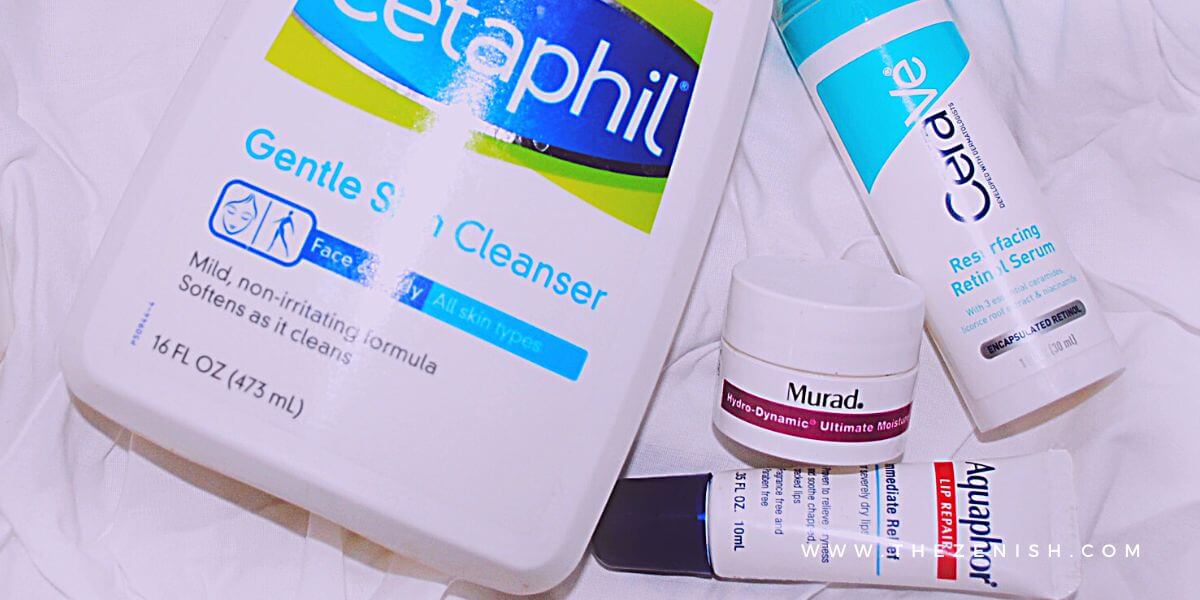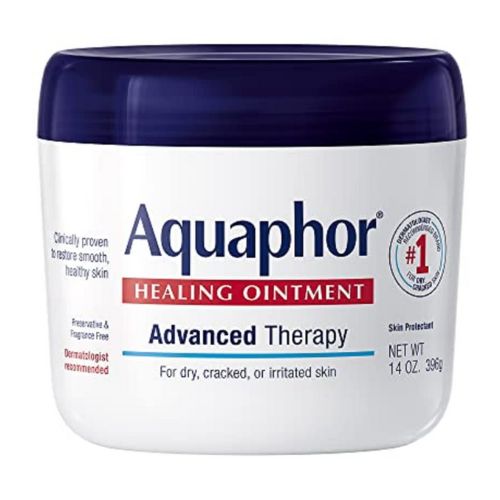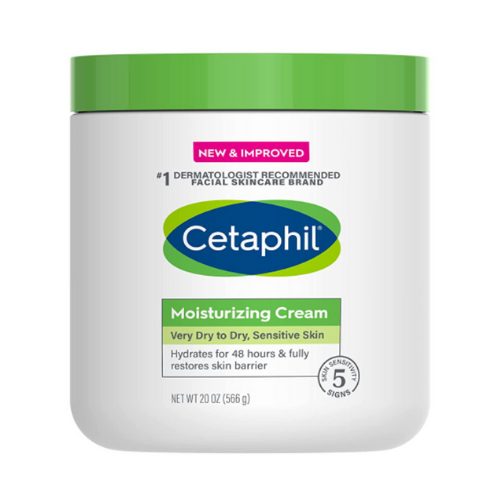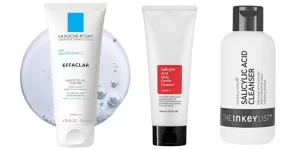
If you have very dry or sensitive skin, it can be hard to find a moisturizer that works for you. You need something that can hydrate and soothe your skin without causing irritation, breakouts, or that icky greasy feeling. You also want something that’s gentle, fragrance free, and affordable.
Two moisturizers that many people with dry and sensitive skin swear by are Aquaphor and Cetaphil. These are classic skincare brands that doctors and users recommend. But how do they differ? Which one is better for your skin?

Let’s compare the two. I’ll compare Aquaphor vs Cetaphil in terms of ingredients, benefits, drawbacks, and suitability for different skin types and conditions. I’ll also share some tips on how to use them correctly and safely for the best results. Let’s get started!
| this post may contain affiliate links, which means if you purchase from one of these links, I may receive a small commission at no additional cost to you. |
Aquaphor: What is it and how does it work?

Aquaphor is an amazing healing ointment that works wonders in repairing and protecting your skin from various issues. It’s a well-known brand that contains 41% petrolatum (A semi-solid mixture of hydrocarbons that forms a protective barrier on the skin, preventing water loss and keeping your skin hydrated and healthy), also known as petroleum jelly or Vaseline.
Aquaphor also contains additional ingredients that aid in repairing and soothing your skin. These include glycerin, panthenol, bisabolol, and lanolin alcohol. You can use it for chapped lips, cracked heels, eczema, psoriasis, burns, wounds, etc.
It can effectively heal dry and damaged skin by restoring the skin barrier function and preventing infection. It can help reduce inflammation, itching, pain, and scarring commonly associated with these skin conditions.
It comes in different-sized tubes, jars, sprays, sticks, etc. You can choose the one that suits your needs and preferences best.
Cetaphil: What is it and how does it work?

If you have dry and sensitive skin, you understand the importance of finding a moisturizer that can effectively hydrate and soothe your skin without causing irritation or pore-clogging. One highly recommended moisturizer by dermatologists and consumers alike is Cetaphil.
Cetaphil is a moisturizing cream formulated with water, glycerin, niacinamide, panthenol, sweet almond oil, petrolatum, and other ingredients. These components work together to effectively hydrate and soothe dry and sensitive skin.
With its rich and creamy texture, the cream spreads easily and absorbs quickly into the skin. It is also fragrance-free, hypoallergenic, and non-comedogenic, which means it won’t cause allergic reactions or acne.
Cetaphil works by delivering long-lasting moisture for up to 48 hours and enhancing the skin barrier function. The skin barrier, which is the outermost layer of the skin, plays a crucial role in shielding it from bacteria, allergens, and pollutants, and preventing water loss. When the skin barrier is damaged or weakened, the skin becomes dry, sensitive, and prone to infections and inflammation.
Cetaphil helps restore and strengthen the skin barrier by delivering moisture and nutrients to the skin cells. It contains glycerin and panthenol, which are humectants that attract water from the air and deeper layers of the skin.
This helps to make the skin more plump and smooth. Additionally, niacinamide (vitamin B3) and sweet almond oil are emollients that soften and condition the skin.
Cetaphil is suitable for dry, very dry, sensitive, and eczema-prone skin. It effectively relieves dryness, itching, redness, flaking, scaling, cracking, and skin tightness. It helps prevent moisture loss caused by environmental factors like cold weather, wind, sun exposure, and air conditioning.
Aquaphor vs Cetaphil: How to choose the best one for your skin?
Both bards are popular and effective, but they have some differences that may make one more suitable for your skin type and condition than the other. Here are some things to consider when comparing Aquaphor and Cetaphil:
Hydration
If you have extremely dry or damaged skin, you may find that Aquaphor provides more intensive healing and protection compared to Cetaphil. Aquaphor is a healing ointment that is specifically designed to address such concerns. However, if you have normal to dry and sensitive skin, you may prefer the Cetaphil moisturizing cream. It offers lightweight and non-greasy hydration, unlike Aquaphor.
Oily or acne-prone
Contrary to popular belief, Aquaphor and Cetaphil are perfectly fine to use if you have acne-prone or oily skin. Yes, both products contain petrolatum, which on its own will not clog your pores and cause breakouts.
In fact, if you have a damaged skin barrier then petrolatum will help to moisturize, strengthen, and protect your skin while it heals.
However, petrolatum is an occlusive ingredient that seals in moisture and prevents water loss, (fantastic) but it can also trap dirt, bacteria, comedogenic ingredients, and sebum in the pores. So, if you use it after cleansing, that’s perfect. However, if you use it over top of pore-clogging products or ingredients, then you’ll probably experience breakouts.
So if you’re trying to decide between “Aquaphor vs Cetaphil for acne” they’re both perfectly fine to use and shouldn’t cause you to breakout, as long as you don’t use them after you wash your face and with other non-comedogenic products.
Eczema or psoriasis
If you have eczema or psoriasis, both the Aquaphor healing ointment and Cetaphil’s moisturizing cream can be incredibly helpful for you. These products effectively moisturize and soothe inflamed skin, providing relief and comfort. They work by restoring and strengthening the skin barrier, delivering essential moisture and nutrients to the skin cells.
They can provide relief from itching, pain, and scarring that are commonly associated with these conditions. However, some people may prefer Aquaphor for its anti-inflammatory properties, while others may prefer Cetaphil for its gentler formula.
To use Aquaphor or Cetaphil correctly and safely for optimal results, here are some tips to follow:
- Use it on clean and damp skin to lock in moisture. You can use them after washing your face with a daily facial cleanser or after taking a shower or bath.
- Use only a thin layer as too much can cause irritation or suffocation of the skin. You don’t need to use a lot of product to get the benefits of moisturization.
- Avoid using them on open wounds or infected areas without consulting a doctor first. They’re not meant to treat serious injuries or infections and may interfere with the healing process or cause complications.
- If you think you might be allergic to an ingredient in one or both products then do a patch test before using Aquaphor or Cetaphil on your face or other sensitive areas to check for any allergic reactions. Apply a small amount of product on a discreet area of your skin and wait for 24 hours to see if there’s any redness, itching, swelling, or rash. If there’s no reaction, you can use the product safely. If there is a reaction, stop using the product and seek medical attention if needed.
Aquaphor vs Cetaphil vs Ointment for very dry or cracked skin
The Aquaphor Healing Ointment, Ointment Advanced Therapy, and Cetaphil Healing Ointment are thicker than your average lotion or cream. This makes them ideal for cracked dry skin, as they form a protective barrier that seals in moisture and prevents water loss. They can also help heal minor wounds and skin irritations by creating a moist environment that promotes healing.
They can be used on both the face and body, but they do have differences in terms of texture, feel, and performance.
Aquaphor is more occlusive than Cetaphil, meaning it creates a thicker and longer-lasting layer on the skin. So using Aquaphor as moisturizer can be beneficial for extremely dry or damaged skin that requires extra protection and healing. However, it can feel a little greasy before it fully absorbs into the skin.
Cetaphil on the other hand is known to be more emollient than Aquaphor, making it easier to spread and absorb quickly into the skin. This can be particularly beneficial if you’re looking for long-lasting hydration and nourishment without the greasy or sticky feeling.
Aquaphor vs Cetaphil Tattoo
Tattoos require proper care and maintenance to ensure their quality and longevity. One key step in tattoo aftercare is moisturizing the tattooed area. Moisturizing helps keep the tattooed skin hydrated, preventing issues such as scabbing, cracking, peeling, fading, or infection.
Both Aquaphor healing ointment and Cetaphil moisturizing cream can be used on tattooed skin. However, they’re used at different phases of the healing stage.
Aquaphor is typically recommended for the initial phase of healing as it helps protect the tattoo from infection and prevents moisture loss. It should be applied in a thin layer once or twice a day for about three to five days after getting the tattoo.
Cetaphil is typically recommended for the second and third phases of the healing stage, as it effectively hydrates and nourishes the tattooed skin without causing irritation or clogging pores. You can apply Cetaphil in a thin layer once or twice a day for approximately two to three weeks after getting the tattoo.
To use Aquaphor or Cetaphil correctly and safely for tattoo aftercare, here are some tips to follow:
- Follow the instructions given by your tattoo artist on how to care for your tattoo.
- Wash your tattoo with mild soap and water before applying Aquaphor or Cetaphil.
- Apply a thin layer of Aquaphor or Cetaphil on your tattoo using clean fingers or a cotton swab.
- Don’t rub or scratch your tattoo as this can damage it or cause infection.
- Avoid exposing your tattoo to direct sunlight, heat, water, or chemicals as this can fade or harm it.
- Keep your tattoo covered with loose clothing or a bandage or plastic wrap until it is fully healed.
Frequently asked questions
Is Aquaphor an antibiotic?
No, Aquaphor is not an antibiotic. It is a healing ointment that helps protect and repair the skin. However, it does not contain any active ingredients that kill bacteria or prevent infections.
If you have an infected wound or a serious skin condition, you should consult a doctor before using Aquaphor.
Is Cetaphil good for tattoos?
Yes, Cetaphil can be good for tattoos as it is a gentle and fragrance-free moisturizer that can help keep your tattooed skin hydrated and prevent scabbing.
However, you should always follow the aftercare instructions given by your tattoo artist and avoid applying Cetaphil on a fresh or unhealed tattoo without their approval.
What is the difference between Aquaphor and Cetaphil in terms of ingredients and formulation?
The main difference between Aquaphor and Cetaphil is that Aquaphor is an ointment, while Cetaphil is a cream (Cetaphil also has a healing ointment).
Ointments are thicker and greasier than creams because they contain a higher proportion of oil compared to water. As a result, ointments provide a longer-lasting moisture seal.
On the other hand, creams are lighter and more watery in consistency, making them a better choice for oily or acne-prone skin.
Can I use Aquaphor or Cetaphil on my face?
Yes, you can use Aquaphor or Cetaphil on your face, but you should be careful and do a patch test first. Apply a small amount of product on a discreet area of your face and wait for 24 hours to see any reaction.
If there is no reaction, you can use the product safely. If there is a reaction, stop using the product and seek medical attention if needed.
Can I use Aquaphor as a facial moisturizer?
Yes, you can definitely use Aquaphor as a facial moisturizer. Unlike typical creams or lotions that simply add water to moisturize your skin, Aquaphor works differently. It helps your skin retain its existing water content and even draws in more moisture from the surrounding air.
So, it’s an excellent choice for keeping your face hydrated and nourished. Use it after your toner, serums, hyaluronic acid, niacinamide, etc. to seal them in and make them more effective.
How often should I use Aquaphor or Cetaphil?
You can use Aquaphor or Cetaphil at least once or twice a day, preferably after washing your face or body with a mild cleanser. You can also use them as needed throughout the day to refresh or protect your skin.
Are Aquaphor and Cetaphil vegan or cruelty-free?
No, Aquaphor and Cetaphil are not vegan or cruelty-free. They both contain animal-derived ingredients such as lanolin alcohol (from sheep’s wool) and petrolatum (from petroleum). They also test their products on animals where required by law.
If you’re looking for vegan or cruelty-free alternatives, you may want to check out other brands that offer similar products with plant-based or synthetic ingredients and do not test on animals.



